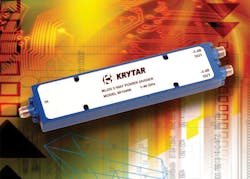Microwave/RF business and engineering efforts may seem to enter “suspended animation” for one week each year—during the annual International Microwave Symposium (IMS) conference and exhibition. But in truth, that is the one week that everyone in this industry marks their calendars for one reason or another. The IEEE is usually wise in their selection of sites, and for 2013 the IMS is scheduled for June 2-7 in the Washington State Convention Center in one of this country’s most beautiful cities: Seattle, WA. The 2013 IMS marks the 61st year of the IEEE’s Microwave Theory & Techniques Society (MTT-S), the largest special-focus technical society driving the 2013 IMS.
The 2013 IMS is actually a collection of events in one place. In addition to the large exhibition hall and the regular IMS technical sessions, visitors can attend the Radio Frequency Integrated Circuit (RFIC) Symposium and the Automatic RF Techniques Group (ARFTG) conference. Both draw healthy crowds of engineers with their respective interests, RF integrated-circuit (IC) design and RF/microwave test and measurement techniques. Also, 2013 is the first year for a mid-week event called “Wireless Industry Day” (see sidebar, “A Day Devoted To The Wireless Industry”), which provides presentations from companies largely in the Seattle area with a main focus on where growing business in wireless technology will be in the years to come.
Related Articles
• Industry Shows Versatility At 2012 IMS
• IMS 2012 Posts Strong Attendance Figures
• Microwaves & RF reports from IMS 2012
Although these special “add-on” technical events might carry enough weight to attract most RF/microwave engineers, especially those working in wireless, RFIC, and test areas, there is no doubt that the regular IMS technical sessions are without equal when it comes to up-to-date information about specific areas of interest to high-frequency engineers and technicians. For example, in a session on low-phase-noise signal generation chaired by Ulrich Rohde, President of Synergy Microwave (Paterson, NJ), a presentation by that same company’s Ajay Poddar provides a closer look at the Mobius-coupled printed resonator oscillators featured on the front cover of this issue. The use of a Mobius coupling mechanism in these new oscillators has made it possible to shrink the size of the components for applications needing sources from 2 to 8 GHz. Experimental units have yielded phase noise of -112 dBc/Hz offset 10 kHz from the carrier.
In that same session, researchers from IBM in Haifa, Israel and East Fishkill, NY have applied that company’sThe technical sessions at the 2013 IMS cover everything from active devices through systems. It is the one week during the year where it is possible to earn an extensive education on almost any technology area. For instance, a session on gallium nitride (GaN) device technology for commercial space applications details processes, devices, and amplifiers for satellite-communications (satcom) use. Presenters from the Japan Aerospace Exploration Agency (JAXA), The University of Tokyo, and a number of companies from Japan and Turkey describe their design of an X-band GaN power amplifier for a small X-band satellite downlink system. The compact, 2-W GaN high-electron-mobility-transistor (HEMT) amplifier will support data rates to 300 Mb/s in the downlink. Presenters from Astrium Satellites from Portsmouth, England will show plans for somewhat larger GaN amplifiers for satellite navigation systems, with amplifiers capable of 80 W output power at S- and L-band frequencies.
The GaN presentations continue with a number of different research teams from Europe. Representatives from the Fraunhofer Institute (Freiburg, Germany), TNO Technical Sciences (Den Haag, The Netherlands), and DA Design (Oy, Finland) will describe submicron AlGaN/GaN monolithic-microwave-integrated-circuit (MMIC) technologies for space applications at X- and W-band frequencies. The technology is capable of MMIC amplifiers with as much as 400 mW output power and 16-dB gain at 90 GHz.
At slightly lower frequencies, a group from the College of New Jersey in Ewing, NJ and Linear Space Technology in Hamilton, NJ will share their work on a GaN solid-state power amplifier based on high-voltage GaN field-effect-transistor (FET) technology. The amplifier, is capable of 170 W peak output power at UHF with impressive power-added efficiency (PAE) of 90%. Designed for use at lower power levels in multicarrier wideband-code-division-multiple-access (WCDMA) cellular-communications systems, it can achieve WCDMA adjacent-channel power ratio of -25 dBc with PAE of 80%.
Of course, this is just a sampling of the presentations available during IMS 2013, with discussions spanning HF through THz frequencies and presentations on analog, digital, and mixed-signal circuits based on silicon, GaAs, GaN, silicon-germanium (SiGe) and essentially every other device technology currently in use at RF and microwave through THz frequencies.
Next year, the 2014 IMS is scheduled for June 1-6 in Tampa, FL. The General Chair of the technical program for 2014 is Larry Dunleavy, President and Chief Executive Officer of high-frequency modeling specialists Modelithics. Those interested in presented a paper in Tampa can contact Dunleavy by way of e-mail, with December 9, 2013 the deadline for submission of technical presentations.
A Day Devoted To The Wireless Industry
In the middle of 2013 Microwave Week is Wireless Industry Day, a full-day seminar co-located with the IMS. Scheduled for Wednesday, June 5, and sponsored by MTT-S chapter MTT-19 and the IEEE Seattle Section, this special event showcases wireless technologies in the Pacific Northwest. This full day of technical sessions actually combines presentations of general interest with talks that address emerging market opportunities for wireless technology in aerospace and medical areas.
Dr. Julio Navarro, Senior Technical Fellow of The Boeing Co. (Seattle, WA), will be one of the local presenters at Wireless Industry Day, offering his presentation, “Key Technology Trends in Wireless for the Aerospace Industry.” This talk will center on the aerospace industry and how it is a prime business factor for many companies in the Northwest. This balanced presentation will explore not only the many options available in terms of technology for wireless device, circuit, and system designers working for aerospace customers, but some of the financial (bottom-line) implications in choosing one technology over another, for example, for designing a broadband receiver.
Another speaker from a nearby company—Bill Saltzstein, President of connectBlue in Redmond, WA—will probe the growing dependence of the medical industry on wireless technology, in his presentation “Bluetooth: The Future of Wireless Medical Technology.” Designers of medical wireless devices anticipate that Version 4.0 of the Bluetooth wireless specification will define the low-power technology needed for many medical applications, where long-running times on battery power are essential.
In addition, major computer companies, such as Microsoft and Apple, have already expressed their support for Bluetooth v4.0, providing a high “confidence factor” for wireless designers working with the new standard. Many feel that the stage is set for new low-power wireless medical applications, and this new standard will help establish lower-cost standard (rather than expensive custom) solutions.
Wireless Industry Day includes some insights from Intel on opportunities for millimeter-wave and terahertz devices and circuits for wireless communications. Dr. Debabani Choudhury, Senior Technologist, and Harry Skinner, Senior Principal Engineer—both from Intel Labs in Hillsboro, OR—offer their presentation, “Prospects and Challenges for GHz to THz Technologies/Architectures for Future Wireless Communications.” The Intel technologists believe that communications using machine-to-machine (M2M) and peer-to-peer (P2P) approaches will require high data rates over short distances, applications which might be filled by millimeter-wave and terahertz device and circuit technologies. Broad bandwidths are available in support of higher data rates at these frequencies, provided that device and circuit technologies can be made affordable.
Additional presentations scheduled for Wireless Industry Day include “Radiated Performance Assessment of Wireless Communications Devices - An Operator’s Perspective” by Scott Prather, Lead Product Development Engineer for AT&T in Redmond, WA, on establishing radiated performance test requirements for emerging wireless applications. Also scheduled is “Evaluating Over-The-Air Performance of MIMO Wireless Devices” by Dr. Michael Foegelle, Director of Technology Development for ETS-Lindgren in Cedar Park, TX, on developing a standardized approach for industry certification of multiple-input, multiple-output (MIMO) wireless devices.
ARFTG Tackles High-Speed Testing
Seattle is also home to the 81st Automatic RF Techniques Group (ARFTG) conference I 2013, scheduled for the last day of Microwave Week (June 7, 2013). The theme of this ARFTG meeting is “Metrology for High Speed Circuits and Systems,” organized into four groups of oral presentations during the day starting at 8 AM. ARFTG has long been a special day at each IMS for test engineers and for anyone seeking to learn more about high-frequency measurements.
The ARFTG oral presentations are accompanied by a miniature version of the IMS exhibition hall, with little booths for each sponsor to show one or two test solutions to attendees. Sponsors for this miniature ARFTG exhibition include Agilent Technologies, Anritsu Co., Electro Rent Corp., Focus Microwaves, Maury Microwave, and RFMD.
The opening oral presentation, by Nick Ridler of the National Physics Laboratory (NPL) in Teddington, England, investigates primary standards of loss for vector network analyzers (VNAs) operating at millimeter-wave frequencies and higher. The standards under study are known as “cross-connected” waveguide; these are straight sections of waveguide, where the waveguide line is oriented such that the waveguide aperture is at right angles to the waveguide apertures on the VNA’s test ports. The cross-cross connected waveguide forms a section of transmission line that is effectively below cutoff. The mechanical discontinuity between the cross-connected waveguide and the VNA test ports also generates significant reflection. Understanding these two loss mechanisms is critical to performing accurate VNA measurements at millimeter-wave and sub-millimeter-wave frequencies.
The opening ARFTG oral session includes a talk on calibrating multi-channel test probes by presenters from Cascade Microtech (Beaverton, OR) and Microsemi (Bend, OR), as well as a unique wideband calibration procedure for systems performing time-domain measurements on nonlinear devices. Offered by presenters from the University of Limoges in Limoges CEDEX, France, this latter presentation details a calibration method based on the use of a wideband, multiple-sine wave signal that is applied to a measurement setup using a four-channel track-and-hold amplifier. The system was used to demonstrate measurements on a 40-W GaN power amplifier driven by a pulsed input signal.
The second ARFTG oral session returns to the topic of waveguide calibration and VNAs, as presenters from the National Institute of Advanced Industrial Science and Technology in Tsukuba, Japan compare waveguide VNA systems calibrated by means of through-reflect-line (TRL) calibrations with different lengths of line. The systems are being used for measurements in the WM-250 (WR-1.0) frequency band from 750 GHz to 1.1 THz.
The calibration employs a new waveguide flange design for precise connections, investigating whether the TRL calibration approach is suitably accurate for VNA measurements at THz frequencies. Additional presentations in the second session cover phase-noise measurements on low-noise oscillators, a field probe for amplitude measurements, and error corrections for pulsed S-parameter measurements. Additional oral sessions offer coverage of active harmonic load-pull measurements at Ka-band frequencies, the use of comb generators for modulated measurements, figures of uncertainty for noise-figure measurements, and the impact of test cable instability on the accuracy of VNA measurements.
RFICs Range From HF To Millimeter Waves
Integrated-circuit (IC) designers and users will find three days of their own at the 2013 Microwave Week in Seattle, as part of the 2013 IEEE RFIC Symposium. Scheduled for June 2-4 also at the Washington State Convention Center, the RFIC Symposium opens the 2013 Microwave Week with presentations, workshops, tutorial lessons, and even an evening reception after the first day of sessions.
The General Chairperson for the 2013 RFIC Symposium is Chris Rudell, from the Electrical Engineering Department at the University of Washington in Seattle. For those interested in a broad spectrum of RFICs, as well as the technologies with which they are fabricated (such as GaAs, GaN, and silicon), the technical program features sessions on high-speed data transceivers, low-power transceivers, front-end circuits, voltage-controlled oscillators (VCOs), frequency control circuits, millimeter-wave systems on a chip (SOCs), and modeling and computer-aided design (CAD).
As an example of one presentation, lecturers from the University of Washington and Avago Technologies will detail their design of a 1.9-GHz oscillator using a phase-noise-reduction technique. Based on a high-quality factor (high-Q) film-bulk-acoustic-resonator (FBAR)/MEMS/crystal architecture, the oscillator signals are frequency-upconverted to 1.9 GHz. Nevertheless, the upconversion approach suppresses the 1/f noise via amplitude-modulation/phase-modulation (AM/PM) conversion, adding a nonlinear capacitor to the oscillator tank circuit.
The proposed AM-PM suppression technique has no additional power penalty and suffers minimal additional volume requirements. By applying the technique, a 1.9-GHz FBAR oscillator was developed with phase noise of -116 dBc/Hz offset 10 kHz from the carrier and -146 dBc/Hz offset 1 MHz from the carrier.
2013 IMS Exhibition Draws International Crowd
As impressive as the technical program for the 2013 IMS is, it is also the industry’s largest exhibition of software, hardware, and test-equipment companies: More than 500 companies will be showing examples of their wares and skills throughout massive exhibition floors, and registration to this portion of the IMS typically exceeds 10,000 attendees each year. The crowd is comprised of visitors from all parts of the globe, in search of new RF/microwave suppliers, advice, or simply to see what their competitors have on display. It is an impressive, three-day showing of some of the top high-frequency engineering companies in the world. What follows is a short sampling of the RF/microwave products on display in Seattle, with more to be found here.
Model 6010400 is a two-way power divider with less than 2.5-dB insertion loss from 1 to 40 GHz. (Photo courtesy of Krytar.)
Krytar, Inc. (Booth No. 2511) will offer a two-way power divider among its passive components on display at IMS 2013. The new two-way model 6010400 power divider (see figure) spans 1 to 40 GHz with less than 2.5-dB insertion loss and better than 14-dB isolation between arms. Suitable for broadband electronic-warfare (EW) and test-and-measurement applications, the power divider exhibits ±0.60 dB amplitude tracking, with phase tracking of ±7 deg. from 1 to 20 GHz and ±14 deg. from 20 to 40 GHz. The maximum input VSWR is 1.85:1 from 1 to 40 GHz, with output VSWR of 1.50:1 from 1 to 20 GHz and 1.70:1 from 20 to 40 GHz. The power divider, which measures 4.15 x 1.00 x 0.43 in. and weighs 3 oz., is supplied with 2.4-mm connectors, but is also available as model 6010400K with 2.92-mm female K connectors. The power divider can be built to meet military specifications.
Related Articles
• Industry Shows Versatility At 2012 IMS
• IMS 2012 Posts Strong Attendance Figures
• Microwaves & RF reports from IMS 2012
EMC Technology, a Smiths Microwave business, will be showing examples of its high-performance passive components, including its new 42UW series of fixed attenuators at Booth No. 541. Built to the requirements of MIL-DLT-3933, these coaxial attenuators are available for operation from DC to 26 GHz, in 0.5-dB attenuation increments from 0 to 20 dB and in 1-dB attenuation increments from 20 to 30 dB. The rugged attenuators feature stainless-steel bodies and SMA connectors. Smiths Microwave is a family of electronic brands that can be found throughout IMS 2013, including EMC Technology, Farran Technology, Florida RF Labs, Kaelus, Lorch Microwave, Millitech, and TRAK Ltd.
Representatives from Molex will be at Booth No. 719 to show their low-loss cable assemblies for applications through 40 GHz, as well as their RF Backplane modular multiport connectors for increased bandwidth in network applications. Also, visitors to the Molex booth can take part in regular live demonstrations of the firm’s RF Cable Assembly Configurator. The software tool helps a user choose the appropriate input and output connectors and cable type for a particular application and set of requirements.
Editor's Note: For more show coverage, be sure to visit Microwaves & RF's IMS 2013 page.
About the Author
Jack Browne
Technical Contributor
Jack Browne, Technical Contributor, has worked in technical publishing for over 30 years. He managed the content and production of three technical journals while at the American Institute of Physics, including Medical Physics and the Journal of Vacuum Science & Technology. He has been a Publisher and Editor for Penton Media, started the firm’s Wireless Symposium & Exhibition trade show in 1993, and currently serves as Technical Contributor for that company's Microwaves & RF magazine. Browne, who holds a BS in Mathematics from City College of New York and BA degrees in English and Philosophy from Fordham University, is a member of the IEEE.



